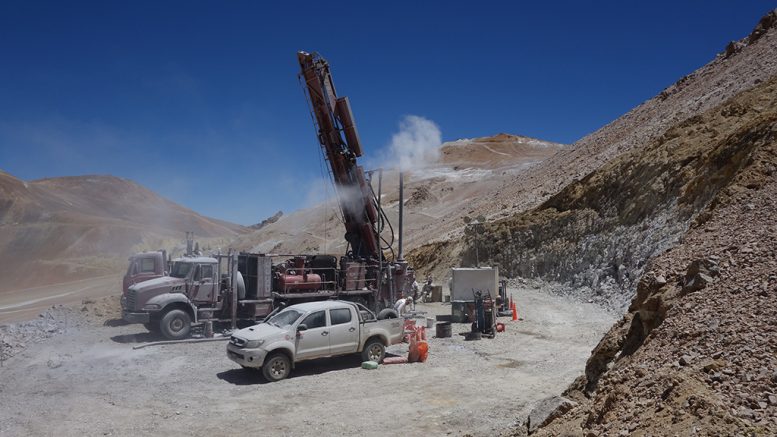VANCOUVER — Filo Mining (TSXV: FIL) was spun out of Lukas Lundin’s NGEx Resources (TSX: NGQ; US-OTC: NGQRF) in mid-2016 to highlight the Filo del Sol copper-gold property that straddles the Chile-Argentia border, 140 km southeast of the city of Copiapo, Chile. The Atacama region is renowned for large copper porphyry deposits, but Filo del Sol is a rarer near-term development opportunity due to its copper-gold mineralogy and heap-leach potential.
Filo del Sol’s inferred resources are 381 million tonnes of 0.39% copper, 0.33 gram gold and 12.2 grams silver. Contained metals total 3.3 billion lb. copper, 4 million oz. gold and 150 million oz. silver.
It’s the low-cost oxide upside, however, that could make it the Lundin Group’s next development project.
“Filo del Sol wasn’t getting recognized in terms of value because it was our third project, but we really, really liked it,” Filo Mining president and CEO Wojtek Wodzicki says in an interview.
The resource combines several mineralization styles owing to complex geological processes. These include high-grade leachable oxide and mixed copper mineralization; structurally controlled gold-silver mineralization; subhorizontal high-grade silver mineralization in mantos; and disseminated copper and gold-silver sulphide mineralization.
“Probably the biggest difference compared to our other regional projects is that the top 250 metres of the deposit are oxidized. We did heap-leach test work on that oxide material that returned really good recoveries. This could lead to lower development costs and a more manageable project size than the Los Helados and Josemaria porphyry scenarios we are working on at NGEx,” Wodzicki says.
Filo has wrapped up a 9,000-metre drill program at the project to boost confidence in the gold-rich portions of the resource, and expand the Filo South zone. The company released its most recent results on April 10, which were highlighted by 112 metres grading 0.73 gram gold from 106 metres deep from infill hole 101, and 102 metres of 0.77% copper from 194 metres deep in hole 111 at Filo South.

The Filo del Sol project, 140 km southeast of the city of Copiapo, Chile, straddles the border between Argentina and Chile. Credit: Filo Mining.
Roughly 180 million tonnes of the resource includes oxide and transitional material that could be amendable to heap-leach processing, but the company hopes its recently drilled Filo South target might grow into a satellite deposit. The results found a zone of “shallow oxide copper and gold mineralization,” 1 km south of resources at the Filo South zone.
Filo’s drilling extended the mineralization along strike and to depth, and started to define a northwest-trending zone of “near-surface copper oxide mineralization,” with associated gold, which runs along strike for at least 300 metres.
“Filo has a more significant gold component to the story. We’ve been dealing with copper-gold porphyry deposits, but this is more analogous to the Veladero or Pascua-Lama type deposits. So there’s a big opportunity to have a gold-only resource in addition to copper,” vice-president of exploration Bob Carmichael says.
“We’re working on the infill drilling, but beyond that we’re looking to recategorize the way we’ve reported the mineral resources. This is thinking more towards what you’d actually be mining, where we have the higher-grade gold zone, the copper-gold oxide zone and the silver zone.”
The company released results from bottle-roll tests at Filo del Sol in October that indicate preliminary recoveries of 95.1% for copper, 93.2% for gold and 92.7% for silver.
“We’ve had a great response from markets in terms of that precious metal component and the oxides,” Wodzicki adds.
“We felt like we could move quickly towards a PEA, but the property-wide exploration potential remains really good because the overall scale of the system is huge. You’re looking at something that’s 7 km long by 2 km wide. There’s still a lot of altered rock out there that we haven’t had a chance to drill.”
The goal is to release an updated resource later this year, which could lead to beginning a preliminary economic assessment (PEA) by September. Filo closed a $20-million private placement in November, when it sold 10 million shares priced at $2 each.
“One thing that’s definitely interesting is the mineralogy of the copper zone. A lot of it is copper sulphate, which is a pretty rare mineral that’s water soluble,” Wodzicki says.
“You could leach that copper with either really low amounts of sulphuric acid, or in some of the test work, it leaches in water. That’s unique, and you want to go after that because it leaches so well,” he says.

Copper sulphate mineralization at Filo del Sol in Chile and Argentina. Credit: Filo Mining.
Filo is also looking at discovery opportunities across the wider property.
The Filo North prospect lies 1 to 2 km north of the deposit in an area thought to host a “potential feeder zone to Filo del Sol.”
The Cerro Vicuna target is a conical hill that surface mapping indicates may be underlain by a silicified and stockwork porphyry intrusive.
The Vicuna Porphyry target has seen grab samples of up to 5 grams gold collected from surface.
Filo Mining shares have traded in a 52-week range of 64¢ to $3 per share, and closed at $1.86 at press time. The company has 61.4 million shares outstanding for a $114.2-million market capitalization.


Be the first to comment on "Filo Mining advances Filo del Sol copper-gold project"